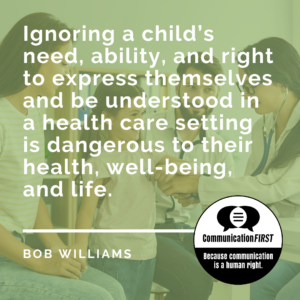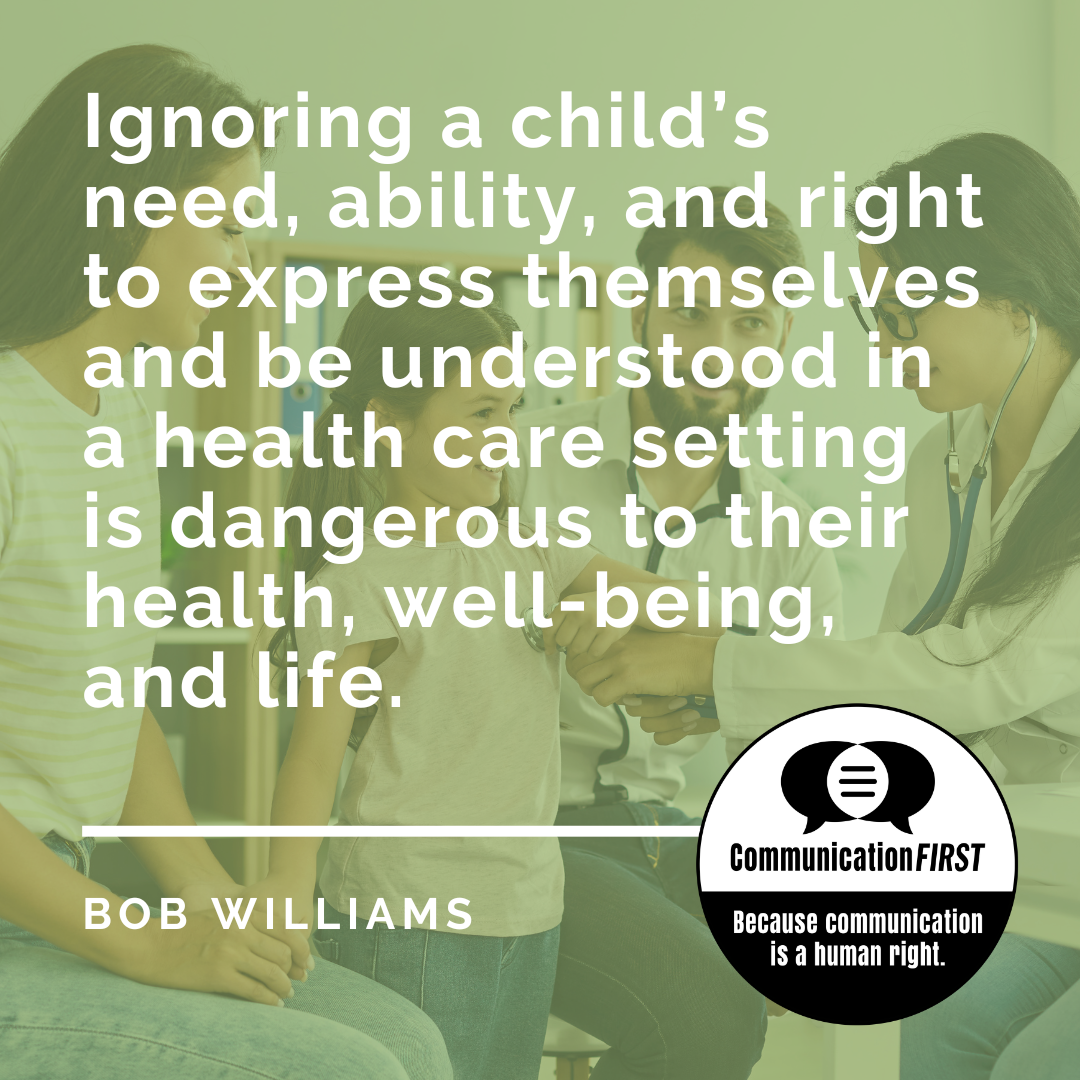Bob Williams Testimony on behalf of CommunicationFIRST on the Rights of Children and Youth to Effective Communication and Quality Health Care in Pediatric and Other Health Care Settings
Supporting Access for Everyone (SAFE) Initiative
October 6, 2022
Good afternoon. I am Bob Williams, Policy Director of CommunicationFIRST. We are the only organization led by and for the estimated 5 million children and adults in the U.S. who cannot use spoken words to effectively communicate and be understood. We instead require typically multiple forms of augmentative and alternative communication, or AAC.
 My pronouns are he, him, and his. I am a white man in my 60’s and I have used one or more ways to express myself since, I am told, I was a toddler in the 1950s. I cannot remember a time when I could not express myself in ways that most eventually understood, even with my garbled speech. But I continue to be the rare exception to what remains a hideous reality. Data is sparse. But based on what data we do have, it seems very likely few kids who require robust, language-based AAC gain timely and effective access to it. In fact, we believe most never gain access. Others secure access to AAC decades later. Research shows Black, brown, and non-English-using school students as well as adults who need AAC often face added barriers and discrimination.
My pronouns are he, him, and his. I am a white man in my 60’s and I have used one or more ways to express myself since, I am told, I was a toddler in the 1950s. I cannot remember a time when I could not express myself in ways that most eventually understood, even with my garbled speech. But I continue to be the rare exception to what remains a hideous reality. Data is sparse. But based on what data we do have, it seems very likely few kids who require robust, language-based AAC gain timely and effective access to it. In fact, we believe most never gain access. Others secure access to AAC decades later. Research shows Black, brown, and non-English-using school students as well as adults who need AAC often face added barriers and discrimination.
Jordyn Zimmerman, the Chairperson of our Board of Directors, spent most of her school years being segregated, restrained most of the day, doing senseless, repetitive activities. Fortunately, when she was 18, Ms. Zimmerman, gained access to a laptop and began typing in words and sentences. A decade later, she has a master’s, is the Director of Professional Development at The Nora Project, and is a rising thought leader.
Jordyn Zimmerman, however, is not exceptional. Increasingly, many young people are accessing the AAC they need. Not because any law or “the system” made such access possible, much less did so in a timely manner. But, in my own experience, that of Jordyn, and many others I have known and continue to meet, we say we gained access to AAC purely by accident. A nonspeaking autistic high school student who only recently accessed AAC described to me how she stumbled on to it “by happenstance.” Well, happenstance is not good enough. Her word choice must haunt and drive all we do.
What does what I have discussed have to do with improving the quality, patient-centeredness, respectfulness, positive long-term outcomes, and power-sharing in pediatric, adolescent, and lifespan health care for people with disabilities who require AAC? Quite simply, it has everything to do with it.
Here are just some of the several recommendations we made in prior testimony on the SAFE Initiative. They are directed at the field of pediatrics, medicine, developmental disabilities, AAC, medical schools, the federal government, parents, and kids. We also highlight the important roles adults with disabilities can and must play. We have deep knowledge, experience, love, pride, and dreams to pass on to our young brothers and sisters that can enhance their health, identities, agency, and lives. Our recommendations are focused on youth who require AAC, but also would benefit all young people.
Recommendation #1. The American Pediatrics Academy, together with HHS and all stakeholders, should develop, finance, and execute strategies that assure all toddlers who require AAC have access to it by the time they are 6 months old. Research demonstrates this is effective. Seeing is believing. Check out the site aackids (hosted by Pennsylvania State University: https://aackids.psu.edu/index.php/page/show/id/1/index.html). Language development must not be held back. Practices like these must be taken to scale now!
Recommendation #2. Pediatricians, hospitals, and others who treat youth who they believe require but lack effective access to AAC have the duty and should be afforded the ready means to assure they access what they need. Ignoring a child’s need, ability, and right to express themselves and be understood in a health care setting is dangerous to their health, well-being, and life. It is discriminatory whether it is done on the basis of their disability and/or primary language.
Recommendation #3. Some physicians and other health care professionals will gladly lay their hands on us. But they will not look at us, talk to us, or listen to us. This extreme ostracism frequently begins in early childhood and continues throughout life, leading to ugly consequences that can never be undone. It also can and does at times result in care not being provided; inferior or improper care; a total lack of effective communication, shared decision making, and informed consent; a fear and reluctance to seek care; unjustified institutionalization, isolation, and restraints; post-traumatic stress, injuries, secondary disabilities, and preventable death. Recently, CommunicationFIRST called on HHS to state in its final Affordable Care Act Section 1557 rules that this and similar behavior in health care settings is disability-based discrimination that will not be tolerated.
Recommendation #4. The SAFE Initiative should work with a broad coalition of disability civil rights, medical, health care, and racial, language access, and social justice organizations as well as federal agencies to develop and carry out strategies to achieve the following complementary aims. The first of these is to assist pediatrics, hospitals, and others to recruit and employ individuals with significant disabilities, particularly people who use AAC, as mentors, health educators, trainers of medical and nursing students, and the like. The second is to create a robust and accessible pipeline that young people who use AAC or have other disabilities can use to prepare, train, and practice in all facets of pediatrics. Thank you.

